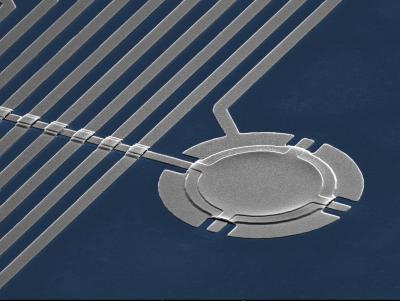BOULDER, Colo.—Physicists at the NationalInstitute of Standards and Technology (NIST)have demonstrated an electromechanicalcircuit in which microwaves communicate witha vibrating mechanical component 1,000 timesmore vigorously than ever achieved before insimilar experiments. The microscopicapparatus is a new tool for processinginformation and potentially could control themotion of a relatively large object at thesmallest possible, or quantum, scale.
Described in the March 10 issue of Nature,* the NIST experiments created stronginteractions between microwave light oscillating 7.5 billion times per second and a "microdrum" vibrating at radio frequencies 11 million times per second. Compared to previouslyreported experiments combining microscopic machines and electromagnetic radiation, therate of energy exchange in the NIST device—the "coupling" that reflects the strength of theconnection—is much stronger, the mechanical vibrations last longer, and the apparatus ismuch easier to make.
Similar in appearance to an Irish percussion instrument called a bodhrán, the NISTdrum is a round aluminum membrane 100 nanometers thick and 15 micrometers wide,lightweight and flexible enough to vibrate freely yet larger and heavier than the nanowirestypically used in similar experiments.
"The drum is so much larger than nanowires physically that you can make thiscoupling strength go through the roof," says first author John Teufel, a NIST research affiliate who designed the drum. "The drum hits a perfect compromise where it's stillmicroscale but you can couple to it strongly."
The NIST experiments shifted the microwave energy by 56 megahertz (MHz, ormillion cycles per second) per nanometer of drum motion, 1,000 times more than theprevious state of the art.
"We turned up the rate at which these two things talk to each other," Teufel says.

This is a colorized micrograph of NISTs aluminum drum, which is 15 micrometers in diameter and 100 nanometers thick. The drum is used in quantum information experiments and ultraprecise measurements of mechanical motion.
(Photo Credit: A. Sanders/NIST)
The drum is incorporated into a superconducting cavity cooled to 40 milliKelvin, atemperature at which aluminum allows electric current to flow without resistance—aquantum property. Scientists apply microwaves to the cavity. Then, by applying a drivetone set at the difference between the frequencies of the microwave radiation particles(photons) and the drum, researchers dramatically increase the overall coupling strength tomake the two systems communicate faster than their energy dissipates. The microwavescan be used to measure and control the drum vibrations, and vice versa. The drum motionwill persist for hundreds of microseconds, according to the paper, a relatively long time inthe fast-paced quantum world.
In engineering terms, the drum acts as a capacitor—a device that holds electriccharge. Its capacitance, or ability to hold charge, depends on the position of the drumabout 50 nanometers above an aluminum electrode. When the drum vibrates, thecapacitance changes and the mechanical motion modulates the properties of the electricalcircuit. The same principle is at work with a microphone and FM radio, but here the naturaldrum motion, mostly at one frequency, is transmitted to the listener in the lab.
The experiment is a step towards entanglement—a curious quantum state linkingthe properties of objects —between the microwave photons and the drum motion, Teufelsays. The apparatus has the high coupling strength and low energy losses needed togenerate entanglement, he says. Further experiments will address whether the mechanicaldrumbeats obey the rules of quantum mechanics, which govern the behavior of light andatoms.
The drum is a key achievement in NIST's effort to develop components forsuperconducting quantum computers and quantum simulations, while also working towardthe widely sought scientific goal of making the most precise measurements possible ofmechanical motion.
Quantum computers, if they can be built, could solve certain problems that areintractable today. The microwave and radiofrequency signals in the new electromechanicalcircuit could be used to represent quantum information. NIST scientists plan to combinethe new circuit with superconducting quantum bits to create and manipulate motion ofrelatively large objects on the smallest (quantum) scales.
The experiment reported in Nature is a prelude to cooling the drum to its "groundstate," or lowest-energy state. Starting from the ground state, the drum could bemanipulated for the applications mentioned above. In addition, such control would enabletests of the boundary between the everyday classical and quantum worlds. The drum alsohas possible practical applications such as measuring length and force with sensitivities atlevels of attometers (billionths of a billionth of a meter) and attonewtons (billionths of abillionth of a newton), respectively.
As a non-regulatory agency, NIST promotes U.S. innovation and industrialcompetitiveness by advancing measurement science, standards and technology in waysthat enhance economic security and improve our quality of life.
Source: National Institute of Standards and Technology (NIST)